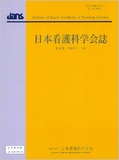Japanese
English
- 販売していません
- Abstract 文献概要
- 参考文献 Reference
要旨
目的:本研究は,クリティカルケア領域の看護場面における看護師−患者間の触れる現象に着目し,日々の看護実践の中で看護師がどのような状況で,どのように患者に触れるのかという観点から,Intensive Care Unitにおける看護師の触れることの特徴を明らかにすることを目的とした.
方法:看護師10名とその受け持ち患者13名に参加観察を行い,看護師に対しては半構造的面接を実施することで,看護師の行動と認識の側面からデータを収集し,テーマ的コード化(Flick, 2007/2011)を参考に分析を行った.
結果・結論:43場面の分析から7つの触れることの特徴が明らかとなった.7つの特徴は,看護師が状況をどのように知覚したのかに応じて現れる看護師の触れる行為であり,7つの特徴には,触れることが常に「手を通した患者の状況把握」として働いていることと,「状況に応じて不断に変化する」という2つの通底している特徴が示された.
This study investigated the physical touch between nurses and patients (hereafter referred to as “touching” of patients by nurses) in critical care situations, particularly characterizing this phenomenon in the intensive care unit (ICU). A qualitative, descriptive design, coupled with data collected from fieldwork and semi-structured interviews, were used in this endeavor. Data were analyzed using with Uwe Flick's thematic coding; data were organized and analyzed in terms of the methods by (and circumstances under) which nurses touch patients while providing healthcare. Ten ICU nurses and 13 patients were recruited as participants, and seven types of touching were identified: 1. Non-invasive touching of the patient's body; 2. touching to prepare for possible changes in the patient's condition; 3. touching to sense the internal state of the patient's body; 4. touching as a stimulus to check the patient's state of arousal; 5. touching a patient to prevent any harm to them and provide peace of mind; 6. touching to assess a patient's reaction and avoid discomfort; and 7. touching to augment verbal communication with non-verbal communication. These characteristics were shown to have certain commonalities. Among others, touching was always performed as a means of tactile, hand-based observation of patient's situation, and was dynamic in nature, depending on the circumstances surrounding the patient-nurse interaction.
Copyright © 2022, Japan Academy of Nursing Science. All rights reserved.


